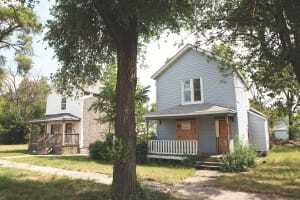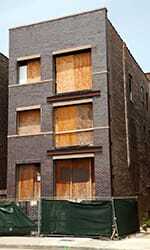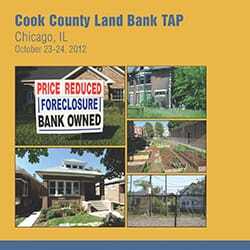The home foreclosure crisis hit Chicago and surrounding Cook County particularly hard. As of summer 2012, nearly 10 percent of the county’s housing units were vacant, and more than 85,000 foreclosure cases were pending. That is when Cook County officials and community leaders kicked off a push to establish a land bank that would be empowered to cut through legal and financial red tape to help get vacant properties ready for productive use again.
Cook County Board President Toni Preckwinkle announced her vision for the land bank in June 2012 at a national conference on vacant property held by the Center for Community Progress. By January 2013, a mere seven months later, the county board of commissioners voted unanimously to establish the Cook County Land Bank (CCLB), the largest in the nation measured by territory covered. The Center for Community Progress, the authority on establishing land banks nationwide, provided a $149,000 grant to fund its startup. This July, the CCLB received a major boost when it was awarded $6 million from Illinois’s portion of the national foreclosure settlement pursued by attorneys general with major banks over their foreclosure practices.
The land bank is designed to selectively acquire vacant properties, maintain and improve them (even if the improvement involves demolition), resolve title and unpaid tax issues, and make the properties available for the private sector to purchase and redevelop. Those sales will help the land bank replenish its coffers—allowing it to continue acquiring other blighted properties.
County Commissioner Bridget Gainer, CCLB chairman, explains the need for a land bank: “There is a market failure right now. We have unprecedented vacancies, and there are developers willing to develop who can’t get title for two years, and when they do, the city is unwilling to release liens for unpaid water taxes.”
The county determined that it could establish the land bank under its home-rule authority, without having to get legislative approval from the state—a key point that allowed the CCLB’s quick establishment. And, Gainer says, it was important during the planning period to confirm that the new CCLB would have the authority to hold properties tax-free while their development potential is being assessed and titles are being cleared. “If you don’t have that tool, there’s not a lot you can do,” Gainer notes.
CCLB committee members hope to have their strategy for land acquisition and disposition policies finalized by the end of October. “At that point we’re going to start considering projects,” Gainer says.
A technical assistance panel (TAP) convened by ULI Chicago in October 2012 provided advice on forming a land bank. “ULI was really instrumental because they brought a level of rigor and professional oversight to it,” Gainer says.
Scott Goldstein, principal with Teska Associates, an urban planning firm in Chicago, was chairman of the TAP. “They really relied on the ULI TAP to fashion the ordinance,” he says. In particular, the organizers sought advice on how a land bank would be viewed by the private sector and on how best to structure its governance, he notes.
“We found that the private sector would benefit greatly,” Goldstein says. He notes that the state of the housing market in Cook County is very mixed, with some areas experiencing a strong market now, but many other areas remaining very weak. “There are areas in Cook County that really need a shot in the arm,” he says. The county ordinance establishing the land bank closely followed the TAP’s recommendations that it be an independent, nonprofit, and quasi-governmental agency—the latter being a key factor enabling the CCLB to resolve tax and lien issues.
In its October 2012 report, the TAP warned that the land bank should be “cautious but smart” in its initial transactions. “Isolated, irregular properties are that way for a reason,” the report notes. “While the land bank can provide a needed function of connecting interested buyers with available land, the goal of the land bank should not be to amass the largest number of properties, but to stabilize the market by being a catalyst for reuse, redevelopment, and repurposing of properties.”
To that end, the CCLB has partnered with the Institute for Housing Studies at DePaul University to develop an open-source analytics tool to help the land bank make informed decisions about acquisition and development. University academics will analyze the county’s real estate and compile data on sales, foreclosures, zoning rules, and other issues to guide decision making.
In addition to rehabilitating neighborhoods, the land bank strategy stands to reduce the foreclosure crisis’s burden on local government. According to the ULI TAP report, “in Chicago, if a foreclosed property is quickly put back on the market, the average cost to local governments is only about $430. If the home languishes and is abandoned and requires demolition, the cost to the local municipality is $34,199.”
Gainer sees the land bank as a method for coping with not only foreclosure-caused vacancies, but also the vacancies caused by demographic change, such as the trend toward smaller households. “We’ve never figured a way to address and to manage declining demand for housing in any other way but community failure,” she notes.
Elizabeth Razzi is editor in chief of Urban Land.



